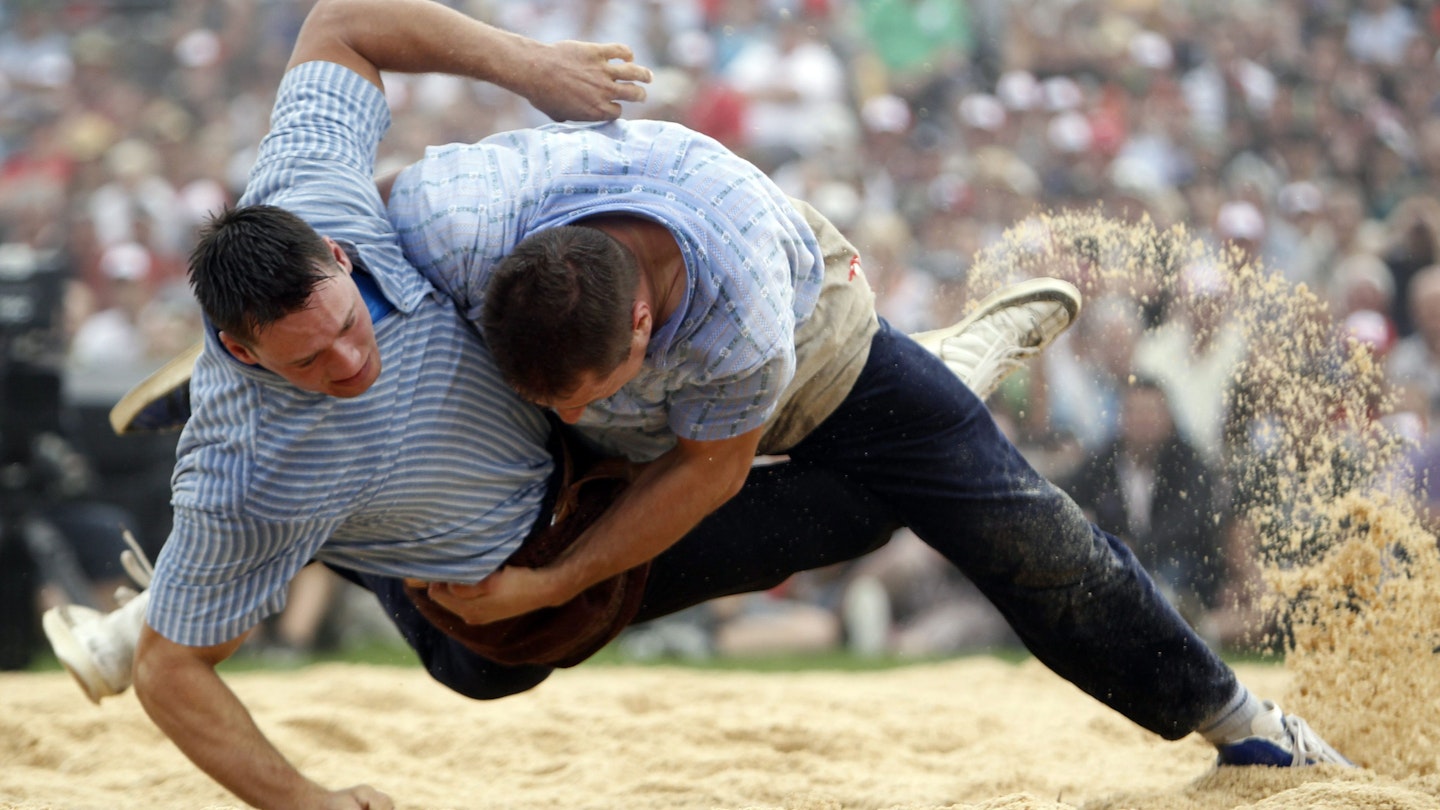Discover Schwingen: The Swiss Wrestling Tradition
It was at the Unspunnen festival in Interlaken in 2017 when I really became aware of just how important Schwingen – or Swiss wrestling – is in Switzerland.
I’d spent the afternoon sitting in the packed stands of a sports arena watching burly men in jute shorts attempt to throw each other onto the ground in a series of one-on-one competitions held in a sawdust-covered ring. The rules were bemusing, the crowd was riveted, and the whole event culminated in the eventual winner being presented with a prize bull called Gottlieb. What, I asked myself, had I just watched?
Later on, I was invited to the press lounge of one of the festival’s big sponsors, a major watch brand, to meet a previous national champion, or Schwingerkönig (king wrestler). Matthias Sempach, a stacked, 194cm-tall thirty-something, was ushered over by the PR person of said watch brand – of which Sempach was an ambassador – after signing some autographs and having his photograph taken. And it was then that I realized: Schwingen isn’t just a quirky traditional Swiss custom; it’s a modern, wildly popular sport and its champions are media stars.
Schwingen in Switzerland: Things to Know Before You Watch
Schwingen sprung up in farming communities across alpine regions. However, like most traditions with rural origins, it’s unclear exactly when. There’s a 13th-century carving in Lausanne cathedral which may depict Swiss wrestling, although experts aren’t convinced. Documents from the later Middle Ages reveal that the sport was in full swing by then, as towns and cities developed a penchant for alpine culture and staged Schwingen competitions at fairs and festivals.
In 1805, the sport became one of the main centerpieces of the first Unspunnen festival, held next to the ruins of Unspunnen castle near Interlaken. This festival celebrated Swiss alpine culture aimed at easing tensions between city folk and rural people.
In the late 19th century, the first national championships were held in the form of the Eidgenössisches Schwing und Älplerfest, now the sport’s biggest event, held every three years. The Eidgenössischer Schwingerverband (ESV, or Federal Wrestling Federation) was created around the same time.
Where to Find Schwingen Competitions
You won’t find too many Schwingen clubs or competitions in Francophone or Italian-speaking parts of Switzerland. However, in Swiss German-speaking areas, Hosenlupf, or “breeches lifting,” is a firm fixture on the sporting calendar, with its major events attracting many thousands of spectators.
Numerous Schwingen events are held in towns and villages throughout the year, including youth competitions and regional festivals. To see the sport at its most celebrated, head to one of the biggest events – if you can get tickets, as they often sell out far in advance.
Top competitors are well-known here. Although it’s still an amateur sport, they pick up lucrative sponsorship deals.
The Rules of the Game
Shorts are crucial to the sport. Each player wears Schwingerhosen, wrestling shorts made of jute and held up by a leather belt. During a bout, which lasts around five minutes, both competitors must grip the back of their opponent’s shorts and use a series of set trips, grips, and throws to try to fling them to the ground. The bout ends when the losing player’s two shoulders touch the sawdust inside the playing circle.
Points are given per bout, adjudicated by a referee and two additional judges who also decide match-ups. The overall winner is the wrestler who picks up the most points, and at the biggest events, his prize is often a Muni (a young bull).
Do Women Participate in Schwingen?
Women’s Schwingen was introduced in 1980, and there’s now an active circuit of events for women and girls, managed by the Eidgenössischer Frauenschwingverband (Women’s Schwingen Association). However, Schwingen is still predominantly a men’s sport.
A Respectful Sport
It’s evident at every Schwingfest that this sport is highly respected by both players and fans. The atmosphere is family-friendly, but they take it as seriously as a die-hard fan at a home game. People attend out of love and pride for this Swiss national sport, often to cheer on their local club members.
Strict etiquette rules govern the competition: opponents must shake hands at the beginning, and the eventual winner always wipes the sawdust from the loser’s back as a mark of respect.
See the National Champ Crowned at the Federal Festival
The Federal Swiss Wrestling and Alpine Festival, where the national champion is crowned Schwingerkönig, is held in a different location every three years. It’s a significant affair that attracts around 400,000 people over the days with major activities including stone-throwing, and unique Swiss sports.
Unspunnen is the Ultimate Schwingen Party
The Olympics of alpine sports is the Unspunnen festival, held only once every 12 years in Interlaken. The festival’s symbol is the Unspunnen stone, used in the stone-throwing competition.
Schwingen Around the Country
Considering the long waiting period for the Unspunnen festival, the organizers hold another Schwingen competition every six years. Events like the Kilchberger Schwinget are primarily for dedicated fans.
Take it Home: Get Yourself an Alpine Shirt
If you want to look the part, consider acquiring a typical blue shirt embroidered with alpine flowers, which have become a symbol of pride in rural life and farming culture.
Swot Up in Advance: Visit the Sports Shorts Museum
A small museum dedicated to Schwingen can be found in Winterthur, showcasing its rich history and cultural significance through various memorabilia.





